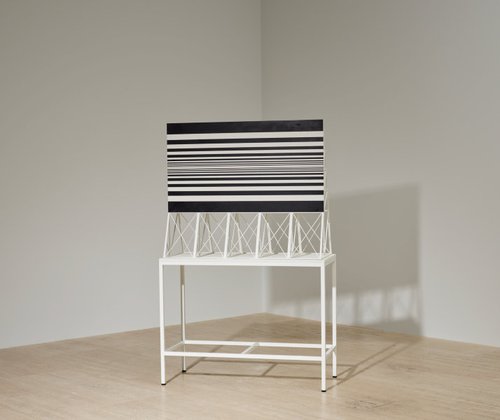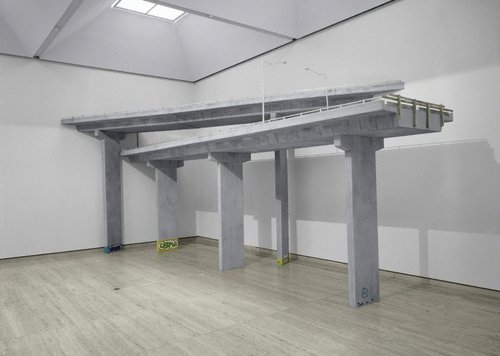-
Details
- Other Title
- Screen #4
- Date
- 2006
- Media category
- Sculpture
- Materials used
- wood and synthetic polymer paint
- Dimensions
-
168.0 x 180.0 x 90.0 cm overall
:
a - screen, 93 x 110 x 45.5 cm
b - table, 88 x 115 x 49.4 cm
- Credit
- Donated through the Australian Government's Cultural Gifts Program by Geoff and Vicki Ainsworth 2010
- Location
- North Building, lower level 2
- Accession number
- 77.2010.a-b
- Copyright
- © Callum Morton, courtesy Roslyn Oxley9 Gallery
- Artist information
-
Callum Morton
Works in the collection
- Share
-
-
About
From large-scale architectural replicas to miniaturised versions of modernist houses replete with flashing lights and the voices of frustrated couples, Callum Morton’s work is adept at creating shifts in perception. Generating mood with light, sound and changes in scale, Morton transforms buildings and objects through disorientating their origins from a specific historical milieu. The result is a ricochet into contemporary times.
‘Screen #4’ is a miniature version of a drive-in cinema screen which has been torched until charred. Drive-in cinemas are now virtually redundant, a nostalgic reminder of the heyday of Hollywood. The first drive-ins were built in the 1930s and they reached their peak in popularity in the 1950s and early 1960s when in America there were over 4000 screens operating. These screens combined the 20th century icons of the film, modernist architecture and the motor car. In the post-war period they seemed to embody a utopian life in which machine, man and image were united rather than alienated, moving towards a better future together. However, just as political and social changes in the 60s disrupted the ‘American Dream’, built as it was on oppressive gender roles, racism and other exclusions, the drive-in was superseded as an outmoded form of entertainment. The reasons for this included the fact that teenagers had greater sexual and social freedoms and no longer needed the privacy of cars at drive-ins, the increase in real estate prices that made the large scale parking lots no longer economically viable, and the general decline in movie attendances with the invention of television.
Morton has dealt with the Utopian modernist architecture associated with the car before, as in the motorway that forms ‘Motormouth’ 2002, (AGNSW collection). The subject of the drive-in perfectly embodies his interest in the disjuncture between modernist ideals and dystopian realities. The drive-in screen showed the projections of Hollywood movies with all their dreams and ideals to mass audiences, and yet here the screen it is reduced to an ashen charred structure. As a blank surface on which these dreams and desires played out, the screen is now in ruins.
-
Exhibition history
Shown in 6 exhibitions
52nd International Biennale of Art, Australian Pavilion, Venice Biennale, Venice, 10 Jun 2007–21 Nov 2007
Collecting lines: selected works from the Geoff and Vicki Ainsworth collection, Maitland Regional Art Gallery, Maitland, 15 Aug 2009–18 Oct 2009
Conquest of space: science fiction and contemporary art, College of Fine Art Galleries, UNSW, , 22 May 2014–05 Jul 2014
Shadow Catchers, Art Gallery of New South Wales, Sydney, 22 Feb 2020–03 Jan 2021
Halfway, Yarrila Arts and Museum, Coffs Harbour, 08 Dec 2023–11 Feb 2024
What Does The Jukebox Dream Of?, Art Gallery of New South Wales, North Building, Sydney, 09 Mar 2024–22 Sep 2024
-
Bibliography
Referenced in 3 publications
-
Creative Australia, Venice Biennale 2007 Australia/ Susan Norrie, Daniel von Sturmer, Callum Morton, 2007, 136 (colour illus.).
-
Andrew Frost, Conquest of space: science fiction and contemporary art, 'The engine of experience: contemporary art and SF', pg. 5-7, Sydney, 2014, 7, 41 (colour illus.), 43.
-
Maitland Regional Art Gallery, Collecting lines: selected works from the Geoff and Vicki Ainsworth collection, Maitland, 2009, 26 (colour illus.).
-



